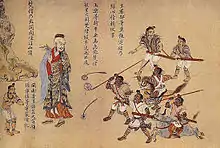နန်ကျောက်
နန်ကျောက် (ရိုးရှင်းတရုတ်: 南诏; ရိုးရာတရုတ်: 南詔; ပင်ရင်: Nánzhào; အင်္ဂလိပ်: Nanzhao, ယီ: ꂷꏂꌅ၊ ) သည် ယခုခေတ် တရုတ်ပြည်တောင်ပိုင်းနှင့် အရှေ့တောင်အာရှတွင် ခရစ်နှစ် ၈-၉ရာစုနှစ်များအတွင်း စည်ပင်ထွန်းကားခဲ့သော တိုင်းပြည်တစ်ခုဖြစ်သည်။ ယနေ့ခေတ် တရုတ်နိုင်ငံ ယူနန်ပြည်နယ်အလယ်ပိုင်းတွင် အဓိကအားဖြင့် တည်ရှိခဲ့သည်။
| နန်ကျောက်(နန်စော) | |
|---|---|
 | |
| လက်ရှိအခြေအနေ | ယူနန်ပြည်နယ်နှင့် ယူနန်အနီးတဝိုက် |
| မြို့တော် | တိုင်းဟီ (also named Yangxiemie, near present day Dali Old Town) |
| ကိုးကွယ်မှု | ဗုဒ္ဓဘာသာ |
| အစိုးရ | ဘုရင်စနစ် |
| နန်ကျောက် | |||||||||
| တရုတ်အမည် | |||||||||
|---|---|---|---|---|---|---|---|---|---|
| ရိုးရာ တရုတ် | 南詔 | ||||||||
| ရိုးရှင်းသော တရုတ် | 南诏 | ||||||||
| |||||||||
| တိဘက်အမည် | |||||||||
| Tibetan | ལྗང | ||||||||
| |||||||||
| ထိုင်းအမည် | |||||||||
| ထိုင်း | น่านเจ้า | ||||||||
| RTGS | Nanchao | ||||||||
| ရှမ်း name | |||||||||
| ရှမ်း | လၢၼ်ႉၸဝ်ႈ (lâan tsāw) | ||||||||

သမိုင်း
တည်ထောင်ခြင်းနှင့် လူမျိုး အမျိုးအစားခွဲခြားခြင်း
နန်ကျောက်တွင် များစွာသော ဘာသာစကားများကိုပြောသည့် မျိုးနွယ်အုပ်စုများပါဝင်သည်။ သမိုင်းပညာရှင်အချို့က နန်ကျောက်မျိုးနွယ်၏ အဓိကလူဦးရေကို ပိုင်လူမျိုး (Bai people)များဖြစ်သည်ဟု ယုံကြည်ကြသည်။[2] သို့ရာတွင် အထက်တန်းလွှာလူများသည် မြန်မာဘာသာစကားနှင့် နီးစပ်သော တိဗက်-မြန်မာအုပ်စု ဘာသာစကားတစ်ခုဖြစ်သော နော့ဆူ (ယီ ဟုလည်းခေါ်သည်) ဘာသာစကားကို မူကွဲတစ်ခုအနေဖြင့် ပြောဆိုခဲ့ကြသည်။[3] ထိုအုပ်ချုပ်သူ အထက်တန်းလွှာ နန်ကျောက်တို့သည် အေဒီ ၂၂၅ ကျူးကော့လျန်၏ တောင်ပိုင်းဒေသစစ်ဆင်ရေး အတွင်းကာလ၌ တိုင်းယွမ်နယ် မှ ယူနန်နယ်သို့ ပြောင်းရွှေ့ခဲ့ပြီးဖြစ်သော (Cuan မျိုးနွယ်စု)မှ ဆင်းသက်လာခဲ့ကြသည်။ လေးရာစုခန့်ရောက်သောအခါ ထိုဒေသကို ပိုင်စိုးခဲ့ပြီးဖြစ်သည်။ ခရစ်နှစ် ၅၉၃၌ တရုတ်ပြည်၏ စွေမင်းဆက်(Sui dynasty)ကို ပုန်ကန်ကြရာ ၆၀၂တွင် လက်စားချေခြင်းအနေဖြင့် နန်ကျောက်တို့ ချေမှုန်းခြင်းခံရသည်။ Cuan လူမျိုးတို့ အုပ်စုနှစ်ခုကွဲရာ မီဝါ (Mywa) အဖြူ နှင့် အမည်း ဟူ၍ အုပ်စုနှစ်ခုဖြစ်လာသည်။[4] အဖြူမီဝါအုပ်စုများ သည် အားဟိုင်ရေကန်ကြီး(Erhai Lake)တဝိုက် မြေဆီဩဇာကောင်းသောအရပ်၌ အခြေချကြသည်။ ဤအုပ်စုများ၌ မုန်းရူ (Mengshe - 蒙舍)၊ မုန်းကွေး (Mengsui - 蒙嶲)၊ လျှန့်ချုံ( Langqiong - 浪穹)၊ တန်းတန် (Dengtan - 邆賧)၊ ရှီးလန် (Shilang - 施浪)၊ ယွဲ့ရှီး (Yuexi - 越析) တို့ပါဝင်ကြသည်။ ကိုယ့်မျိုးနွယ်စုနှင့် ကိုယ်ပိုင်ပြည်ထောင်ငယ်များဖြစ်ကြသည်။ ထိုပြည်ထောင်ဒေသများကို ကျောက် (zhao) ဟူသော အသံဖြင့် အသိများသည်။ ကျောက် ဆိုသည့်ဝေါဟာရကို ထိုင်း(သို့)ရှမ်းဘာသာဖြင့် စဝ်၊ မြန်မာဘာသာဖြင့် စော ဖြစ်သည်။ ထို့ကြောင့် နန်ကျောက် (သို့) နန်စောဟု လည်းခေါ်ဆိုနိုင်သည်။ အထက်ပါနယ်တစ်ခုဖြစ်သော Mengshe - 蒙舍 ကို မိုင်းဆည်စောဟု ခေါ်နိုင်သည်။ နန်ကျောက် သို့ နန်စော ကို တောင်ဘက်စောနယ်ဟု မြန်မာလိုသုံးနှုန်းနိုင်သည်။ [5]
၇၀၄တွင် တိဗက်အင်ပါယာက ဤနယ်များကို ၎င်းလက်အောက်ခံနယ်မြေများဖြစ်စေခဲ့သည်။[4] ၇၃၇တွင် ထန်မင်းဆက်(Tang dynasty)၏ အကူအညီဖြင့် မိုင်းဆည်စော (Mengshe) ဘုရင် ဖီလော်ကော့(Piluoge - 皮羅閣) က အဆိုပါ နန်စောခြောက်နယ်ကို ဆက်တိုက်သိမ်းယူနိုင်ခဲ့၍ နန်ကျောက်ဟု အမည်တွင်သည့် တိုင်းပြည်ကိုစုစည်းတည်ထောင်ခဲ့လေသည်။ မြို့တော်ကို တိုင်းဟီ၌ (အေဒီ - ၇၃၈)တွင် တည်ထောင်သည်။ (ယခုခေတ် ယူနန်ပြည်နယ် တာ့လီ၏ တောင်ဘက်မိုင်အနည်းငယ်အကွာတွင်တည်ရှိသည်။) အားဟိုင်တောင်ကြားဒေသ၌ တည်ရှိသဖြင့် တည်နေရာအနေအထားမှာ အထူးကောင်းမွန်၏ ။ တိုက်ခိုက်လာလျှင် ခုခံရလွယ်ကူ၍ မြေဆီဩဇာကောင်းသည်။[6]
ပညာရှင်နယ်ပယ်၌ နန်ကျောက် (နန်စော) တိုင်းပြည်တွင်ရှိသော မျိုးနွယ်စုဖွဲ့စည်းပုံအား နှစ်တစ်ရာခန့်ကြာကြာ ယခုထိတိုင် အငြင်းပွားလျှက်ရှိသည်။ တရုတ်ပညာရှင်များက အုပ်ချုပ်သူလူတန်းစားများသည် ပိုင်(Bai) သို့ ယီ(Yi) မျိုးနွယ်မှဖြစ်ကြသည်ဟုဆိုသော သဘောတရားကို နှစ်သက်ဟန်ရှိသည်။ တရုတ်လူမျိုးမဟုတ်သော ပညာရှင်များက တိုင်းရှမ်းမျိုးနွယ် (Thai ethnic groups)သည် အဓိကလူဦးရေဖြင့် ယင်းနိုင်ငံကို ဖွဲ့စည်းထားသည်၊ ထို့နောက်မှ တောင်းပိုင်း (ယခုခေတ်)ထိုင်း၊ လာအို စသည့်ဒေသများသို့ ပြောင်းရွှေ့ခဲ့ကြောင်းဆိုသည့် သဘောကို လက်ခံထားသည်။[7]
နယ်မြေချဲ့ထွင်ခြင်း
ဖီလော်ကော့ သက္ကရာဇ် ၇၄၈တွင် ကံကုန်တော်မူ၍ သားဖြစ်သူ ကော်လော်ဖဲင့် (Geluofeng - 閣羅鳳)[6] တရုတ်ခရိုင် ယူနန်အုပ်ချုပ်ရေးမှူးမှ နန်ကျောက်သံတမန်များကို ၇၅၀တွင် ဓားပြတိုက်ရန်ကြိုးပမ်းသည်။ ကော်လော်ဖဲင့်က ထိုအရာရှိကို သတ်ခဲ့ပြီး ထန်မင်းပိုင်သော အနီးနားနယ်မြေအချို့ကိုလည်း သိမ်းယူလိုက်သည်။
တုံ့ပြန်လက်စားချေသောအားဖြင့် ကျင်းနန် (ယခု - စီချွမ်း) နယ်စား Xianyu Zhongtongက နန်ကျောက်ကို ၇၅၁၌ ပြန်တိုက်သည်။ စစ်သည်အင်အား ၈၀,၀၀၀ခန့်ဖြစ်၏ ။ ၎င်းကို နန်ကျောက်က တွမ့်ကျင့်ဝေက (Duan Jianwei - 段俭魏) က ရှန့်ကွမ်းခရိုင်(Xiaguan)တွင် ပြန်တိုက်ထုတ်ခဲ့သည်။ အကျအဆုံးများ၏ (ကျဆုံးသူများစွာမှာ ရောဂါကြောင့်ဟုလည်းဆို)။[8][9] တွမ်ကျင့်ဝေ အုတ်ဂူသည် ရှန်ကွမ်းအနောက် ၂ ကီလိုမီတာအကွာတွင်ရှိ၍ သောင်းဂဏန်းရှိသော စစ်သည်များ အုတ်ဂူတို့ကား တျန်ပေါင် ဥယျာဉ်အနီးတွင်ဖြစ်သည်။ ထို့နောက် ၇၅၄၌ ထန်စစ်သည် ၁၀၀,၀၀၀ခန့်ကို စစ်သူကြီး လီမိ(Li Mi 李宓)ခေါင်ဆောင်၍ မြောက်ဘက်မှ နန်ကျောက်တိုင်းပြည်သို့ ချီတက်လာခဲ့သည်။ Mu'ege အရပ်မှ ဆက်၍ မကျော်နိုင်ခဲ့ပါ။ ၇၅၄ အဆုံးတွင် ကော်လော်ဖဲင့်သည် တိဗက်များနှင့် မိတ်ဖွဲ့၍ ထန်မင်းကိုဆန့်ကျင်ခဲ့သည်။ထိုမဟာမိတ်အဖွဲ့သည် ၇၉၅အထိ တည်တန့်ခဲ့၏ ။[8]
၈၀၁တွင် နန်ကျောက်နှင့် ထန်စစ်တပ်တို့သည် တိဗက်နှင့် အဘာစစ် မွတ်ဆလင်ကျွန်တပ်တို့ကိုချေမှုန်းခဲ့သည်။[10]
ဤအောင်မြင်မှုက ကျားကန်ပေးသည့်အတွက် နန်ကျောက်တို့သည် မြန်မာပြည်အတွင်းသို့ အလျှင်အမြန် နယ်မြေချဲ့ထွင်ခဲ့သည်။[11] ၈၂၀တွင် ပျူမြို့ပြနိုင်ငံများကို အောင်မြင်၍ ၈၃၂၌ ပျူများကို ဖယ်ရှားနိုင်ခဲ့သည်။[12] ၈၂၉တွင် ချန်ဒူး(Chengdu)မြို့ကို တိုက်ခိုက်၍ နောက်တစ်နှစ်တွင် ထိုမှ ဆုတ်ခွာရသည်။[13] ၈၃၀တွင် အနီးနားတိုင်းပြည်များဖြစ်သော အရှေ့ဘက်က Kunlunနှင့် တောင်ပိုင်းမှ Nuwang နိုင်ငံများကို အောင်မြင်သည်။[14]
နန်ကျောက်တို့ ထန်နိုင်ငံတောင်ဘက် အစွန်းရှိ အားနန်(Annam)ကိုလည်းရုတ်တရက်ကျူးကျော်တိုက်ခိုက်ခဲ့သည်။[14] ထန်ဧကရာဇ် ရွှမ်ကျုန်း (Xuānzong) အေဒီ ၈၅၉၌ ကံကုန်တော်မူခဲ့ပြီးနောက် ထန်နှင့် နန်ကျောက်တို့ ဆက်ဆံရေးပျက်ခဲ့သည်။ အကြောင်းမှာ နန်ကျောက်ဘုရင် ရှိလုံ(Shilong)သည် ထန်မင်းကွယ်လွန်ခြင်းနှင့်ပတ်သက်၍ ဝမ်းနည်းကြောင်းသဝဏ်လွှာကို လက်ခံမည့် ထန်နိုင်ငံသံတမန်များကို အထင်သေးစွာဆက်ဆံ၍ ပေါကျို(Bozhou) နှင့် အာနန်ကို ရုတ်တရက်ဝင်တိုက်သောကြောင့်ဖြစ်သည်။[15] ရှိလုံသည် ၈၃၆၌ အာနန်ကို ထပ်မံတိုက်ခိုက်ခဲ့ကာ သုံးနှစ်ကြာ နယ်မြေကို သိမ်းယူထားနိုင်ခဲ့သည်။[16] သက္ကရာဇ် ၈၆၉၌ ချန်ဒူးမြို့ကို တိုက်ခိုက်သော်လည်း မအောင်မြင်ခဲ့ပေ။[16]
ကျဆုံးခြင်း
အေဒီ ၈၇၃အရောက်တွင် နန်ကျောက်တို့ကို စီချွမ်းနယ်မှ မောင်းထုတ်နိုင်ခဲ့ပြီးဖြစ်သည်။ ရှန်းရှီနယ်မှ ယန်မိသားစုဖွဲ့စည်းထားသော ဒေသတပ်က ၈၇၇တွင် နန်ကျောက်တို့ကို ပေါကျို (ယနေ့ခေတ် -ကွေ့ကျို) မှမောင်းထုတ်နိုင်ခဲ့သည်။[16] တိုင်းပြည် ဖြည်းဖြည်းခြင်းပျက်သောအခါ နန်ကျောက်တို့ ယူနန်သို့ဆုတ်ခွာလာသည်။ ၉၀၂တွင် အမတ်အကြီးအကဲတစ်ပါးမှ အိမ်ရှေ့မင်းသားအပါအဝင် အဓိကဘုရင့်မျိုးတော်များကိုသုတ်သင်ခဲ့သဖြင့် နန်ကျောက်မင်းဆက် သွေးမြေကျအဆုံးသတ်ခဲ့ရသည်။ ထို့နောက် မင်းဆက်သုံးခု ဆက်တိုက်ဆိုသလို ပေါ်ပေါက်လာခဲ့ရာ ၎င်းတို့မှာ Da Changhe (၉၀၂-၉၂၈)၊ Tianxing(၉၂၈-၉၂၉)၊ Da Yining(၉၂၉-၉၃၇)တို့ဖြစ်ကြ၏ ။ နောက်ဆုံး၌ တွမ့်စစ်ဖျင်က ၉၃၇တွင် အာဏာရရှိလာကာ တာ့လီပြည်(Dali Kingdom)ကို တည်ထောင်ခဲ့သည်။
ဘာသာရေး

နန်ကျောက်ဒေသသည် ဝိရာယာန (Vajrayana or Tantric Buddhism)ဗုဒ္ဓဘာသာနှင့်ပတ်သက်မှု ခိုင်မာသည်။[17] (ယနေ့ခေတ်-ကျင့်ချွမ်းနယ်နှင့် အနီးပြည်နယ်များတွင် ရှိသည်)။ ကွမ်ယင်(မယ်တော်)နှင့် မဟာကာလ (Mahākāla) ကိုးကွယ်မှုသည် တရုတ်ပြည်ဗုဒ္ဓဘာသာ၏ အခြားသောပုံစံများနှင့် လွန်စွာကွဲပြားသည်။ [18] နန်ကျောက်တို့ ပုဂံနိုင်ငံ၊ တိဗက်ပြည်နှင့် ဝင်္ကဒေသ(Bengal)တို့နှင့်လည်း ဘာသာတရားဆက်သွယ်မှု ရှိကောင်းရှိနိုင်သည်။[19]
နန်ကျောက်နှင့် တာ့လီဒေသတို့တွင် ကိုးကွယ်သော အဓိကဗုဒ္ဓဘာသာပုံစံမှာ ဝိရာယာနပုံစံဖြစ်သော အာစရ (သို့) အာချာရ( အင်္ဂလိပ်: Azhali ၊ သက္ကတ: ācārya) ဘာသာအဖြစ် အသိများသည်။ ၈၂၁-၈၂၄၌ အိန္ဒိယပြည်မှလာသော ဘုန်းတော်ကြီး Li Xian Maishun (ဆရာတော် စန္ဒြဂုမ္ဘ [20])က တည်ထောင်ခဲ့သည်။ အိန္ဒိယဒေသမှ ဘုန်တော်ကြီးများပိုမိုရောက်ရှိလာကာ ဟို့ရှင်း(Heqing)နယ်တွင် ဘုရားကျောင်းတစ်ခုတည်ထားခဲ့သည်။[21] နန်ကျောက် (နန်စော)၏ နောက်ဆုံးမင်းသည် ဗုဒ္ဓဘာသာကို ထိုဒေသ၏ တရားဝင်ဘာသာအဖြစ် တည်ထောင်ခဲ့သည်။[22]
ကိုးကား အညွှန်များ
- Stein, R. A. (1972) Tibetan Civilization, p. 63. Stanford University Press. ISBN 0-8047-0806-1 (cloth); ISBN 0-8047-0901-7 (pbk)
- Joe Cummings, Robert Storey (1991)။ China, Volume 10 (3, illustrated ed.)။ the University of California: Lonely Planet Publications။ p. 705။ ISBN 0-86442-123-0။ 15 May 2011 တွင် ပြန်စစ်ပြီး။
- C. X. George Wei (2002)။ Exploring nationalisms of China: themes and conflicts။ Indiana University: Greenwood Publishing Group။ p. 195။ ISBN 0-313-31512-4။ 15 May 2011 တွင် ပြန်စစ်ပြီး။
- Beckwith 1987, p. 65.
- စိန့်တိုင်း(ဂန္ဓလရာဇ်တိုင်း)၊ ဥတည်ဘွား၊ တရုတ်တရက် အမည်များ၏ ဇစ်မြစ် - ရည်စိန်
- Blackmore 1960.
- Zhou၊ Zhenhe; You၊ Rujie (2017-09-08)။ Chinese Dialects and Culture (အင်္ဂလိပ်ဘာသာစကားဖြင့်)။ American Academic Press။ p. 187။ ISBN 9781631818844။
- Herman 2007, p. 30.
- Twitchett 1979, pp. 444–445.
- Beckwith 1987, p. 157.
- Coedès 1968, pp. 95, 104–105.
- Herman 2007, p. 33, 36.
- Herman 2007, p. 33, 35.
- Herman 2007, p. 35.
- Herman 2007, p. 36.
- Herman 2007, p. 37.
- Megan Bryson, "Baijie and the Bai: Gender and Ethnic Religion in Dali, Yunnan", Asian Ethnology 72, 2013, pp. 3-31
- Megan Bryson, "Mahākāla worship in the Dali kingdom (937-1253) – A study and translation of the Dahei tianshen daochang yi", Journal of the International Association of Buddhist Studies 35, 2012, pp. 3-69
- Thant Myint-U, Where China Meets India: Burma and the New Crossroads of Asia, Part 3
- စိန့်တိုင်း(ဂန္ဓလရာဇ်တိုင်း)၊ ဥတည်ဘွား၊ တရုတ်တရက် အမည်များ၏ ဇစ်မြစ် - ရည်စိန်
- Howard, Angela F. “The Dhāraṇī pillar of Kunming, Yunnan: A legacy of esoteric Buddhism and burial rites of the Bai people in the kingdom of Dali, 937–1253”, Artibus Asiae 57, 1997, pp. 33-72 (see p. 43-44).
- Nanzhao State and Dali State။ City of Dali။ 2006-09-03 တွင် မူရင်းအား မော်ကွန်းတင်ပြီး။
ယေဘူယျ ကိုးကားစာအုပ်များ
- Andrade၊ Tonio (2016)။ The Gunpowder Age: China, Military Innovation, and the Rise of the West in World History။ Princeton University Press။ ISBN 978-0-691-13597-7။.
- Asimov၊ M.S. (1998)။ History of civilizations of Central Asia Volume IV The age of achievement: A.D. 750 to the end of the fifteenth century Part One The historical, social and economic setting။ UNESCO Publishing။
- Barfield၊ Thomas (1989)။ The Perilous Frontier: Nomadic Empires and China။ Basil Blackwell။
- Barrett၊ Timothy Hugh (2008)။ The Woman Who Discovered Printing။ Great Britain: Yale University Press။ ISBN 978-0-300-12728-7။
- Beckwith၊ Christopher I. (1987)။ The Tibetan Empire in Central Asia: A History of the Struggle for Great Power among Tibetans, Turks, Arabs, and Chinese during the Early Middle Ages။ Princeton University Press။CS1 maint: ref=harv (link)
- Blackmore, M. (1960). "The Rise of Nan-Chao in Yunnan". Journal of Southeast Asian History 1: 47–61.
- Bregel၊ Yuri (2003)။ An Historical Atlas of Central Asia။ Brill။
- Coedès၊ George (1968)။ Walter F. Vella (ed.)။ The Indianized States of Southeast Asia။ ဘာသာပြန်သူ Susan Brown Cowing။ University of Hawaii Press။ ISBN 978-0-8248-0368-1။CS1 maint: ref=harv (link)
- Drompp၊ Michael Robert (2005)။ Tang China And The Collapse Of The Uighur Empire: A Documentary History။ Brill။
- Ebrey၊ Patricia Buckley (1999)။ The Cambridge Illustrated History of China။ Cambridge: Cambridge University Press။ ISBN 0-521-66991-X။ (paperback).
- Ebrey၊ Patricia Buckley; Walthall၊ Anne; Palais၊ James B. (2006)။ East Asia: A Cultural, Social, and Political History။ Boston: Houghton Mifflin။ ISBN 0-618-13384-4။
- Golden၊ Peter B. (1992)။ An Introduction to the History of the Turkic Peoples: Ethnogenesis and State-Formation in Medieval and Early Modern Eurasia and the Middle East။ Otto Harrassowitz · Wiesbaden။
- Graff၊ David A. (2002)။ Medieval Chinese Warfare, 300-900။ Warfare and History။ London: Routledge။ ISBN 0415239559။
- Graff၊ David Andrew (2016)။ The Eurasian Way of War Military Practice in Seventh-Century China and Byzantium။ Routledge။ ISBN 978-0-415-46034-7။.
- Haywood၊ John (1998)။ Historical Atlas of the Medieval World, AD 600-1492။ Barnes & Noble။
- Herman၊ John E. (2007)။ Amid the Clouds and Mist China's Colonization of Guizhou, 1200–1700။ Harvard University Asia Center။ ISBN 978-0-674-02591-2။CS1 maint: ref=harv (link)
- Latourette၊ Kenneth Scott (1964)။ The Chinese, their history and culture။ 1–2။ Macmillan။
- Lorge၊ Peter A. (2008)။ The Asian Military Revolution: from Gunpowder to the Bomb။ Cambridge University Press။ ISBN 978-0-521-60954-8။
- Luttwak၊ Edward N. (2009)။ The Grand Strategy of the Byzantine Empire။ The Belknap Press of Harvard University Press။
- Millward၊ James (2009)။ Eurasian Crossroads: A History of Xinjiang။ Columbia University Press။
- Needham၊ Joseph (1986)။ Science & Civilisation in China။ V:7: The Gunpowder Epic။ Cambridge University Press။ ISBN 0-521-30358-3။
- Rong၊ Xinjiang (2013)။ Eighteen Lectures on Dunhuang။ Brill။
- Schafer၊ Edward H. (1985)။ The Golden Peaches of Samarkand: A study of T'ang Exotics။ University of California Press။
- Shaban၊ M. A. (1979)။ The ʿAbbāsid Revolution။ Cambridge: Cambridge University Press။ ISBN 0-521-29534-3။
- Sima၊ Guang (2015)။ Bóyángbǎn Zīzhìtōngjiàn 54 huánghòu shīzōng 柏楊版資治通鑑54皇后失蹤။ Yuǎnliú chūbǎnshìyè gǔfèn yǒuxiàn gōngsī။ ISBN 957-32-0876-8။
- Skaff၊ Jonathan Karam (2012)။ Sui-Tang China and Its Turko-Mongol Neighbors: Culture, Power, and Connections, 580-800 (Oxford Studies in Early Empires)။ Oxford University Press။
- Twitchett၊ Denis C. (1979)။ The Cambridge History of China, Vol. 3, Sui and T'ang China, 589–906။ Cambridge University Press။CS1 maint: ref=harv (link)
- Wang၊ Zhenping (2013)။ Tang China in Multi-Polar Asia: A History of Diplomacy and War။ University of Hawaii Press။
- Wilkinson၊ Endymion (2015)။ Chinese History: A New Manual, 4th edition။ Cambridge, MA: Harvard University Asia Center distributed by Harvard University Press။ ISBN 9780674088467။
- Xiong၊ Victor Cunrui (2000)။ Sui-Tang Chang'an: A Study in the Urban History of Late Medieval China (Michigan Monographs in Chinese Studies)။ University of Michigan Center for Chinese Studies။ ISBN 0892641371။
- Xiong၊ Victor Cunrui (2009)။ Historical Dictionary of Medieval China။ United States of America: Scarecrow Press, Inc.။ ISBN 0810860538။
- Xu၊ Elina-Qian (2005)။ Historical Development of the Pre-Dynastic Khitan။ Institute for Asian and African Studies 7။
- Xue၊ Zongzheng (1992)။ Turkic peoples။ 中国社会科学出版社။
- Chapter 3: Military Campaigns against Yunnan: A Cross-Regional Analysis။ Between Winds and Clouds: The Making of Yunnan (Second Century BCE to Twentieth Century CE)။ Columbia University Press (2008a)။
- Chapter 4: Rule Based on Native Customs။ Between Winds and Clouds: The Making of Yunnan (Second Century BCE to Twentieth Century CE)။ Columbia University Press (2008b)။
- Yang၊ Bin (2008c)။ Chapter 5: Sinicization and Indigenization: The Emergence of the Yunnanese။ Between Winds and Clouds: The Making of Yunnan (Second Century BCE to Twentieth Century CE)။ Columbia University Press။
- Yuan၊ Shu (2001)။ Bóyángbǎn Tōngjiàn jìshìběnmò 28 dìèrcìhuànguánshídài 柏楊版通鑑記事本末28第二次宦官時代။ Yuǎnliú chūbǎnshìyè gǔfèn yǒuxiàn gōngsī။ ISBN 957-32-4273-7။
- Yule၊ Henry (1915)။ Cathay and the Way Thither: Being a Collection of Medieval Notices of China, Vol I: Preliminary Essay on the Intercourse Between China and the Western Nations Previous to the Discovery of the Cape Route။ Hakluyt Society။
Further reading
- Backus၊ Charles (1981)၊ The Nan-chao Kingdom and T'ang China's Southwestern Frontier၊ Cambridge University Press၊ ISBN 978-0-521-22733-9.
- Chan၊ Maung (March 28, 2005)။ Theravada Buddhism and Shan/Thai/Dai/Laos Regions။